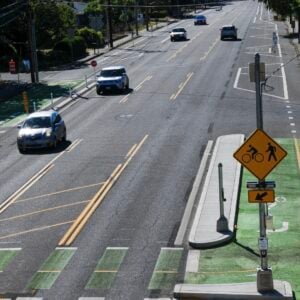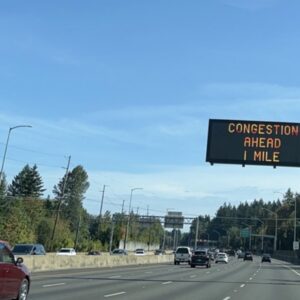I hate to be so blunt, but ever since I attended one of those Bike Safety Workshops, I can’t stop thinking about two things.
- The difference of a mere 10mph in a car (which is barely perceptible), can mean a vast difference in the fatality rate if that car strikes a biker or walker.
- Cops seem to “allow” at least a 10 mph cushion on the posted speed limit before giving a ticket.
There was something upsetting to me about those two thoughts hitting my head at the same time.
To illustrate how important it is to drive slowly (especially on neighborhood streets), I’ve posted a slide from the City of Portland’s traffic division. It lists the effects of speed on stopping distance shows fatality and injury rate for each speed. How can the police can justify allowing motorists to go 10-15 miles over the posted speed limit when the numbers in the chart below make it painfully obvious that people die as a result?
Maybe someone from the Portland Police Bureau or the city traffic engineering office can enlighten me.
[click the image to enlarge]








Thanks for reading.
BikePortland has served this community with independent community journalism since 2005. We rely on subscriptions from readers like you to survive. Your financial support is vital in keeping this valuable resource alive and well.
Please subscribe today to strengthen and expand our work.
Wow. Yeah if our safety was a little further up the importance scale, and the attitude that speed in big cars is king not so prominent, perhaps we’d see lower speed limits and requirements that car manufacturers think about pedestrians, like what Toyota is already doing:
“It’s now developing a sensor that will accurately detect a pedestrian within a range of six metres, and will automatically brake the vehicle. For example, a speed of 40 km/h could be reduced to half that before impact.
To help reduce pedestrian head injuries in such collisions, Toyota is testing impact-absorbing vehicle structure in the hood and the area near the windshield wipers. As well, impact-absorbing front bumpers may lessen the risk of pedestrian leg injuries. ”
http://autonet.ca/DriverSource/Stories.cfm?StoryID=10149
Of course, impact-absorbing materials may help to some extent, but unless they use like 2 feet of jello, I doubt they could make a truck (with its hood aimed right at your heart) safe for pedestrians in a collision.
A UK ad agency made a really good public service announcement about the effect of speed and casualty rate. I haven’t seen it on tv here in the US, but the information is in mph, so it must have been made for the US (I can’t think of anyone else using mph). Their numbers are a little different than what’s listed above, but the announcement is perfect from an ad agency standpoint. It put the message so hard into my head that 6ish months after watching it one time I still remember it everytime I go through a school zone.
This tv spot is a little disturbing, make that exceptionally disturbing, so don’t watch it within a couple hours of going to sleep.
http://www.ad-awards.com/home.php?rub=3&tri=categories&category=6&pub=76
Good to hear that the majority of a dense city can start to accept that fast cars are the real terrorists likely to harm your loved ones.
Portland residents and city leaders have yet to accept slower speeds and a tiny bit less parking.
Safety is related to speed, but another hidden factor is parked cars that block views near crosswalks. I’d love to see a story on that.
Both legal and illegal parking causes some near misses in front of my house. When I asked for help, PDOT’s response was to quote the law that the pedestrian has the duty to not step out in front of cars. But what if the ped is a kid, or someone who can’t retreat if a car speeds around these blind curves?